|
===================================================
How To Break 80 Newsletter
November 29, 2006
"The Web's Most Popular Golf Improvement Newsletter"
===================================================
In this issue we'll discuss...
1) Reading Break from off the Green
2) Square Alignment: The Box-and-One Drill
3) Question of the Week- Hitting Hybrids
4) Article- The Real Secret To Excellent Putting
5) Article- Finally…Three Slice Fixes That Actually Work
Special Note: Want to learn to putt better? Stay tuned next week
when I release my brand new Putting DVD....designed just for my
readers.
===================================================
1) Reading Break from off the Green
===================================================
Hitting a shot from the fringe of the green demands special attention. It not only saves strokes, it also builds confidence in your short game. Unfortunately, we often underestimate the shot’s difficulty and blow it, costing ourselves strokes.
A key part of making this shot is reading the break from off the green. As a general rule, the more air you put under the ball, the less the green affects its roll. But you should still check the break on the ball even if the ball’s run is short.
Playing from off the green breaks down into three situations.
-Putting from the fringe
-Hitting a low running shot
-Hitting a high, soft shot
If you’re putting from the fringe, or hitting a low running shot that will hit the fringe before rolling onto the green, play the same amount of break as if you were putting from the green—just take into account the direction of the fringe grass. Dark grass means the grain is against you, slowing the ball down. Shiny grass means the grass is with you, speeding the ball up.
If you’re hitting a low running shot onto the green with a low lofted iron or a fairway wood, the key is the slope of the landing area. Low shots with these clubs travel faster than high shots with wedges. That means the slope will affect the ball less, at least until it slows down.
If you’re hitting a high shot onto the green with a short iron or wedge, the slope in your line has a bigger impact on the ball. That’s because the ball is traveling a lot slower than if you hit it with a low-lofted club or a fairway wood.
Keep these three situations in mind when your approach shot lands on the fringe. They simplifying strategy and make it easier to hit the shot close to, or even into, the hole.
=================================================== 2)
Square Alignment: The Box-and-One Drill
===================================================
If you’re making solid contact off the tee but spraying the ball all over the course, you might have an alignment problem. Basically, there are two ways golfers misalign themselves. Some aim their feet at the target, then ignore their arms, hips, and/or clubface. Others offset their alignment to compensate for a swing fault, like a slice or a pull. Neither way encourages consistency or accuracy.
The problem is that you stand to the side of the ball at address, forcing you to view the target from an angle instead of head on. That shift in position can throw off your aim, resulting in misalignment. If you want to hit the ball down the middle consistently, you must achieve square alignment every time.
One way to check your alignment is the box-and-one drill. Here are 5 keys to the drill:
1. Tee the ball opposite your left heel (right-handers)
2. Imagine an invisible rectangular box on the ground
3. Make the box as square as possible
4. Picture the ball in the left-hand corner
5. Bring the clubface into the ball
At address, tee the ball opposite your left heel. With that line established, draw an imaginary rectangular box on the ground. The box’s left side is the line between your left heel and the ball; the box’s right side is the line between your right heel and a point behind and even with the ball.
Try to make the box as square as possible. Open the toe of your left foot slightly to allow for your hips to clear. Now, take a normal golf swing. Concentrate on bringing the clubface squarely into the ball in the box’s upper-left hand corner. Follow through as you normally would.
Using the box-in-one drill helps achieve square alignment. Proper alignment in turn improves consistency and accuracy off the tee without short-circuiting power.
=================================================== 3)
Question of the Week- Hitting Hybrids
===================================================
From W MacGillivary
Hitting Hybrids
Q. Hi, Jack. I always hit my long irons better than my new hybrid, a 3-iron equivalent. Does the hybrid require a different set-up, ball position, or swing? I have spoken to many golfers (shooting in the mid-90s) who have the same problem.
A. Thanks for the question. The hybrid is practically a “universal” club. Easier to hit than a fairway wood or a long iron, a hybrid is ideal for a wide variety of lies. It has a loft usually from 16 degrees to 25, a low-center-of-gravity, a smaller clubhead, and a lower profile. It can be used off the tee, from the fairway and rough, in fairway bunkers, and near the green.
Generally speaking, you hit a hybrid as if you were hitting a 6-iron or a 7-iron, employing a down-and-through swing. Here are some other tips on hitting a hybrid:
-If you’re hitting a hybrid off the tee, tee the ball low and position it near the center of your stance but towards the target.
-If you’re hitting a hybrid from the fairway, position the ball closer to the center of your stance, swing more down and through the ball, and strike the ball first, taking a small divot.
-If you’re hitting a hybrid from a fairway bunker, position the ball in the center of your stance, dig your feet into the sand, and take a shorter swing.
-If you’re hitting a hybrid from the rough, position the ball in the center of your stance, use a three-quarter backswing, accelerate down and through the ball, and finish with a full follow-through.
-If you’re hitting a hybrid from near the green, hit the ball as if you were hitting a typical pitch-and-run shot.
A hybrid is a highly versatile club. It’s ideal for a wide variety of situations, so don’t be afraid to use it, if you have one. The hybrid takes some getting used to, though, so plan for it.
If you've got a golf question you'd like answered, send an email to us at
questions@howtobreak80.com and we'll review it. I can't guarantee that we'll use it but if we do, we'll make sure to include your name and where you're from.
===================================================
If you want to truly discover the secrets of shooting like the Pros and creating a more reliable and consistent swing, check out:
http://www.HowToBreak80.com
P.S. Feel free to share this newsletter with family and friends. If you
would like to subscribe to this newsletter, send a blank email to
break80ezine@aweber.com
===================================================
About the Author
===================================================
Jack Moorehouse is the author of the best-selling book
"How To Break 80 and Shoot Like the Pros!". He is NOT a golf pro, rather a working man that has helped thousands of golfers from all seven continents lower their handicaps quickly. His free weekly newsletter goes out to thousands of golfers worldwide and provides the latest golf tips, strategies, techniques and instruction on how to improve your golf game.
Gary Winnick
|
Tools To
Help Your Game!
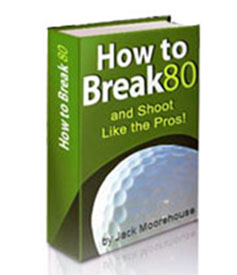
eBook
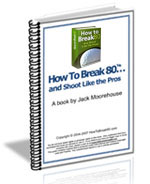
Physical Book
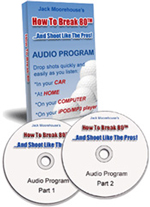
Audio Program
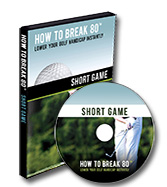
Short Game DVD
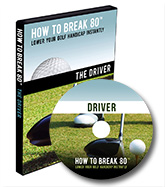
Driver DVD
|